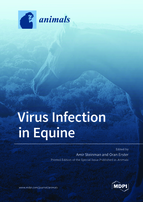Virus Infection in Equine
A special issue of Animals (ISSN 2076-2615). This special issue belongs to the section "Equids".
Deadline for manuscript submissions: closed (30 November 2021) | Viewed by 25690
Special Issue Editors
Special Issues, Collections and Topics in MDPI journals
Special Issue Information
Dear Colleagues,
In recent decades, horses, which have served humans throughout history as working animals, have become an important companion animal, thus increasing their direct contact with humans, including specific sensitive populations, such as when used for therapeutic riding. Therefore, horses have an important role in maintaining the health of humans and the environment under the concept of One Health (OH). However, much like any other animal, horses can also be the source of zoonotic diseases—and with the recent increase in international transportation and global warming, we are experiencing a much quicker spread of viral diseases to new niches, as with the current COVID-19 outbreak.
The emergence of West Nile virus in 1999 in New York and soon afterwards in the entire American continent drew attention to emerging and re-emerging viral zoonotic diseases, further demonstrating the importance of better surveillance of equine viral diseases. Since then, we have experienced the spread of other viruses to new niches, some of which cause disease only in horses such as the Equine Encephalosis virus, whereas others may also affect humans, such as the Usutu virus.
Equine viral diseases have significant health as well as financial effects not only on the equine industry but also on humans. Eastern equine encephalitis, for example, is one of the most dangerous mosquito-borne diseases in the United States and has a high fatality rate in people who become ill. Equine Influenza, on the other hand, is not zoonotic but may cause substantial economic losses as happened during an outbreak in Australia in 2007, which cost the Australian government 350 million dollars.
The overall aim of this Special Issue is to provide updated information regarding all aspects of equine viral diseases, including their prevalence, pathogenesis, diagnostics, therapeutics, and prevention strategies, including vaccination. We hereby invite authors to submit original high-quality papers that provide a significant contribution to the understanding of these various aspects of equine viral diseases.
Dr. Amir Steinman
Dr. Oran Erster
Guest Editors
Manuscript Submission Information
Manuscripts should be submitted online at www.mdpi.com by registering and logging in to this website. Once you are registered, click here to go to the submission form. Manuscripts can be submitted until the deadline. All submissions that pass pre-check are peer-reviewed. Accepted papers will be published continuously in the journal (as soon as accepted) and will be listed together on the special issue website. Research articles, review articles as well as short communications are invited. For planned papers, a title and short abstract (about 100 words) can be sent to the Editorial Office for announcement on this website.
Submitted manuscripts should not have been published previously, nor be under consideration for publication elsewhere (except conference proceedings papers). All manuscripts are thoroughly refereed through a single-blind peer-review process. A guide for authors and other relevant information for submission of manuscripts is available on the Instructions for Authors page. Animals is an international peer-reviewed open access semimonthly journal published by MDPI.
Please visit the Instructions for Authors page before submitting a manuscript. The Article Processing Charge (APC) for publication in this open access journal is 2400 CHF (Swiss Francs). Submitted papers should be well formatted and use good English. Authors may use MDPI's English editing service prior to publication or during author revisions.
Keywords
- equine
- virus
- vaccination
- epidemiology
- zoonosis








